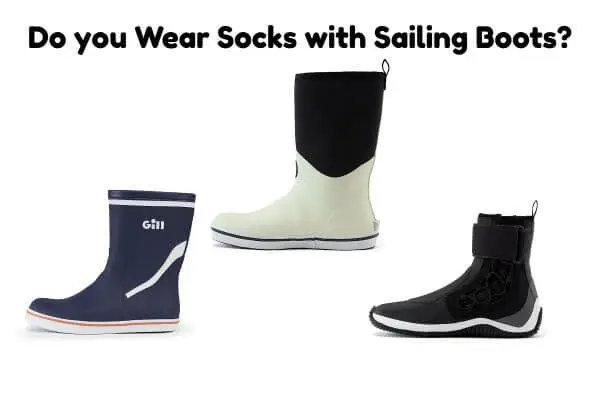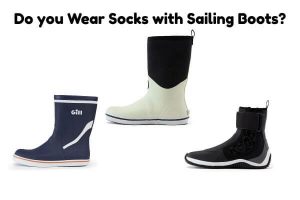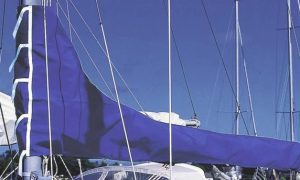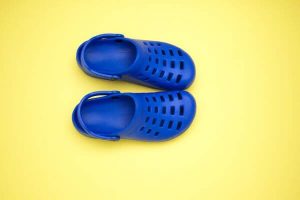I wear socks with my sailing boots for reasons of comfort and because the smell gets really bad if I don't. That said I never look as trendy or cool as others, but I sail because I enjoy it, I never look like I'm about to do a photoshoot for Tatler magazine.
A little further down I show you my "Best Buy" Sailing Socks.
Anyway let's look at your options.
Do you wear socks with sailing boots? Many sailors ask this question. Let's explore why.
It depends on the activity and personal preference. If you're competing, sockless may help with grip and control. But if you want comfort, you might want to wear socks.
The type of material matters too. Synthetic socks can keep feet dry in wet conditions.
So, it's vital to consider comfort and performance before setting sail.
Socks are a great help but if you want to avoid blisters and be comfortable while sailing make sure you have good quality sailing boots.

Table of Contents
- Anyway let's look at your options.
- Best Buy Sailing Socks
- Neoprene Socks
- Understanding the purpose of wearing socks with sailing boots
- Types of socks suitable for sailing boots
- Proper technique for putting on socks with sailing boots
- Maintaining and caring for socks and sailing boots
- Expert tips and recommendations for maximizing sock and boot performance
- Conclusion
- Frequently Asked Questions
- Read other Sailing Gear Posts:
Best Buy Sailing Socks

Neoprene Socks
These are the ones you should buy. They are 3mm Water Sports Socks, Anti-Slip for Diving, Snorkelling, Swimming, Surfing and Sailing.
Understanding the purpose of wearing socks with sailing boots
Understanding the Purpose of Wearing Socks with Sailing Boots:
Wearing socks with sailing boots serves several important purposes:
- Enhancing Comfort: Socks act as a protective barrier between the skin and the boot, preventing friction that can lead to blisters and discomfort.
- Moisture Management: Socks help absorb and wick away moisture, keeping the feet dry and reducing the risk of fungal infections, such as athlete's foot.
- Temperature Regulation: Socks provide insulation, keeping the feet warm in cold weather and preventing excessive sweating in warm conditions.
- Odor Control: By absorbing sweat and moisture, socks help minimize odor and keep the boots smelling fresh.
Additionally, wearing socks can also increase the lifespan of the sailing boots by reducing wear and tear caused by direct contact with the skin. It is important to choose socks that are specifically designed for sailing or outdoor activities, as they are often made from moisture-wicking materials and offer additional padding and support.
One interesting fact to note is that socks were originally made from animal skins by ancient civilizations such as the Romans and Egyptians. However, modern advancements in textile technology have led to the development of specialized socks that cater to the specific needs of sailors and outdoor enthusiasts. (Source: National Geographic)
"Protect your feet with socks, because blisters make terrible dance partners on the slippery deck."
Importance of wearing socks for comfort and protection
Wearing socks with sailing boots is essential. They act as a barrier between your feet and the boots, stopping blisters, chafing, and discomfort. Socks also help absorb moisture, keeping your feet dry. Plus, they give you cushioning and insulation.
To improve comfort and protection, consider these ideas:
- Get socks made from moisture-wicking materials like merino wool or synthetic blends. These fabrics draw sweat from the skin.
- Choose seamless socks to stop blisters forming.
Also, try padded or cushioned socks for extra support. This absorbs shock and reduces strain on your feet. Especially helpful during intense sailing activities or longer trips.
Lastly, select the right size of socks. Snug, but not too tight. Tight socks can lead to discomfort and decreased blood flow, which affects performance. Comfort and functionality are key when selecting sailing boot socks.
Types of socks suitable for sailing boots
Types of socks suitable for sailing boots:
Sailing boots require specific types of socks that provide comfort, protection, and optimal performance on the water. Here are three types of socks that are suitable for sailing boots:
- Neoprene socks: Made from a synthetic rubber material, neoprene socks provide excellent insulation and water resistance. They are ideal for cold weather conditions and can keep your feet warm in wet environments. The stretchy material ensures a snug fit inside the boots, preventing blisters and providing extra cushioning.
- Merino wool socks: Known for their natural moisture-wicking and thermal properties, merino wool socks are a popular choice for sailors. These socks regulate temperature and keep your feet dry, preventing odors and reducing the risk of fungal infections. They offer padding and comfort, making them suitable for long hours on the boat.
- Coolmax socks: Designed for high-performance activities, Coolmax socks are made from a blend of synthetic fibers that provide moisture management and quick drying. These socks wick away sweat from your feet, keeping them cool and dry during intense sailing sessions. They also offer cushioning and support, reducing foot fatigue.
When selecting socks for sailing boots, it's important to consider the material, thickness, and fit. Additionally, avoid cotton socks as they retain moisture and can lead to discomfort and blisters. Remember to choose socks that are comfortable, breathable, and provide adequate protection for your feet while sailing.
Pro Tip: Before wearing your sailing boots, make sure to try them on with your chosen socks to ensure a proper fit and avoid any discomfort or rubbing.
Say goodbye to swampy feet and hello to dry sails with these moisture-wicking materials, because nobody wants a slip 'n slide situation on the high seas.
Materials that provide moisture-wicking properties
Are moisture-wicking materials essential for sailing boots? Yes! Discover the top materials that wick away moisture: Merino Wool, Polyester, Nylon, and CoolMax. Bamboo fabric also offers great moisture-wicking abilities.
For best results, opt for socks with reinforced toes and heels. Also, look for cushioning in key pressure points. Lastly, consider compression socks for improved circulation and reduced fatigue.
Choose the right materials and features for a great sailing experience!
Cushioning and support features for long hours on the boat
For comfort while sailing, cushioning and support features are essential. These features provide stability, reduce fatigue, and prevent injuries.
- Arch Support: Built-in arch support keeps the foot's natural shape. This spreads weight and reduces pressure on the feet.
- Padded Heel and Toe: Extra padding in these areas absorbs shock. This helps protect feet and makes sailing for long hours more comfortable.
- Moisture-Wicking Technology: Sweat is drawn away from the skin with this feature. This stops blisters and keeps the feet cool.
- Ankle Compression: Compression technology improves blood flow and reduces swelling. This can be a bonus on long trips.
Unique details like seamless construction and reinforced stitching are also available. Seamless construction stops friction, and reinforced stitching makes socks suitable for rough conditions.
To make sailing more comfortable:
- Choose socks made from moisture-wicking materials.
- Pick socks with cushioning in the heels and toes.
- Look for socks with compression technology.
- Invest in seamless socks and reinforced stitching.
By selecting the right socks and following these tips, sailors can enjoy long hours on the boat in comfort.
Proper technique for putting on socks with sailing boots
Socks are an essential component for sailors when wearing boots, as they provide comfort, warmth, and protection. Proper technique for donning socks with sailing boots is crucial to ensure a secure and comfortable fit.
When preparing to put on sailing boots, it is important to select suitable socks. Opt for moisture-wicking socks made from materials like merino wool or synthetic blends. Avoid cotton socks as they retain moisture and can lead to discomfort and blisters.
Before putting on the socks, ensure the boots are clean and free from any debris. Gently stretch the sock and insert your foot into it, ensuring a smooth fit. Make sure the socks are pulled up and snug around your feet, providing a secure and comfortable base for the boots.
With your socks in place, put on the sailing boots by inserting your foot into the boot opening. Push gently on the heel of the sock to ensure it is positioned correctly within the boot. Once the foot is inside the boot, use the appropriate fastening mechanisms, such as laces or straps, to secure the boot in place.
- Step 1: Choose the right socks
- Step 2: Ensure a proper fit
- Step 3: Put on the sailing boots
It is also important to note that sock thickness should be considered when choosing sailing boots. Thicker socks may require larger-sized boots, while thinner socks may allow for a snugger fit. Experiment with different combinations to find the perfect balance of comfort and support.
For optimal performance, ensure that the socks and boots are worn together as a cohesive system, providing the necessary support and protection. Additionally, it is recommended to periodically check and adjust the fit of both socks and boots throughout your sailing adventure to maintain optimal comfort and prevent discomfort or blisters.
By following these steps and considering the appropriate sock materials and boot fit, sailors can enjoy a comfortable and enjoyable experience on the water.
Sailing boots that fit perfectly are like finding the love of your life - they provide comfort, support, and just the right amount of toe wiggle room.
Ensuring a snug and comfortable fit
For a comfy fit when wearing sailing boots, make sure to follow these steps:
- Make sure to select the right pair of socks. Look for ones made from moisture-wicking materials.
- Pull them all the way up to your calves. Avoid creases and wrinkles.
- Double-check your sailing boots are the right size.
- Additionally, wear thin liner socks under thicker ones for extra cushioning.
Follow these steps for a snug, comfortable fit every time. Don't miss out on the perfect sailing experience! Ensure your feet are supported and protected throughout your time on the water.
Avoiding bunching or slipping of socks inside the boots
Wondering how to ensure your socks stay in place inside your sailing boots? Follow these 6 steps and you'll be ready to sail with confidence!
- Choose the right sock material - moisture-wicking materials like merino wool or synthetic blends.
- Size matters - make sure your socks fit snugly, but not too tight.
- Smooth out wrinkles - before putting on your boots, smooth out any wrinkles.
- Roll them up - start by rolling your socks up from the toe area towards the ankle.
- Insert foot gently - slide your foot into the boot slowly, keeping the rolled-up section intact.
- A final adjustment - unroll any remaining folded sections, making sure they lie flat against your skin.
Plus, choose sailing boots that provide a secure fit around the ankle and have adequate cushioning. Then, set sail without worry of discomfort or blisters. Enjoy life's adventures with confidence and comfort!
Maintaining and caring for socks and sailing boots
Maintaining and caring for socks and sailing boots is crucial to ensure their longevity and proper functionality. Here are some important points to consider:
- Keep the socks and boots clean by regularly washing them with mild soap and warm water. Avoid using harsh chemical cleaners, as they can damage the fabric and material.
- After washing, air-dry the socks and boots thoroughly to prevent moisture buildup, which can lead to unpleasant odors and the growth of bacteria or fungi.
- Inspect the socks and boots for any signs of wear or damage, such as holes, loose seams, or worn-out soles. Repair or replace them as necessary to maintain their effectiveness and prevent potential injuries.
- Store the socks and boots in a cool, dry place away from direct sunlight. Extreme temperatures can degrade the materials and shorten their lifespan.
- Consider using specialized products, such as waterproof sprays or conditioners, to enhance the water-resistance and durability of your sailing boots. Follow the instructions provided by the manufacturer for optimal results.
Furthermore, it is important to note that socks and sailing boots should be worn together to provide additional comfort, cushioning, and protection against friction and blisters. This combination helps to maintain a secure and snug fit, preventing chafing and ensuring a comfortable sailing experience.
For added care, it is recommended to rotate between multiple pairs of socks and boots. This allows each pair to dry and recover fully between uses, reducing odor buildup and extending their lifespan. Additionally, using moisture-wicking socks can help keep your feet dry and prevent excessive sweating.
Investing in quality socks and boots is essential for sailing enthusiasts. By properly maintaining and caring for them, you can enjoy comfortable and safe voyages for years to come.
Who needs a dishwasher when you have sailing boots? Just rinse and repeat until your socks are squeaky clean!
Cleaning and drying techniques
Clean your socks and boots by shaking or brushing them. Fill a basin with lukewarm water and a small amount of detergent. Place the items in the water, agitate them to remove any stains, then rinse thoroughly. Dry your socks by laying them flat or hanging up with clothespins. Stuff your sailing boots with newspaper to absorb moisture and keep their shape. Put them in a well-ventilated area away from heat. Refer to the manufacturer's guidelines for specific care instructions.
Prolong the lifespan of your gear with proper care. Get ready for anything that comes your way on the high seas. Don't miss out on memorable moments due to worn-out gear. Take action now to keep your socks and boots in top-notch condition!
Storing and organizing equipment for future use
To optimize the gear storage system, you can follow these tips:
- Label and categorize each item! Assign a specific label and group them according to their purpose. This'll make it easier to locate and retrieve stuff when needed.
- Invest in shelves, racks, or storage containers. Make sure there's enough room to store all the equipment. They'll keep everything well-organized and safe.
- Keep track of temperature, humidity, and sunlight. The environment can affect the condition of stored gear. Adjust your storage methods for the best outcome.
Additionally, you can:
- Use digital inventory systems. It'll give easy access and updates.
- Rotate similar equipment like socks or boots. This'll prevent any one set from wearing out quickly.
- Use proper cleaning supplies. Follow manufacturer guidelines for the best results.
By following these tips, you can store and organize your equipment properly. This will save time and money in the long run. Plus, your gear will always be ready for your next adventure.
Expert tips and recommendations for maximizing sock and boot performance
Maximizing sock and boot performance when sailing? Expert tips count. Here are some key points:
- The right socks: Go for moisture-wicking materials, like merino wool or synthetic blends, to keep feet dry and comfy.
- Size is key: Try on different sizes to find the perfect fit - too tight or loose can lead to blisters.
- Layer it up: For colder sailing, wear several layers of socks. Ensure the boots have enough room.
- Cushioning counts: Look for added cushioning in high impact areas - heel and ball of foot. This aids shock absorption and reduces fatigue.
- Boot liners: They provide insulation, support and protection against abrasions. Look for ones designed for sailing boots.
Remember, everyone's feet are unique. What works for someone else may not work for you. Experiment with your socks and boots until you find what's best.
Pro tip: Before heading out, check boots are clean and free from debris that could cause discomfort or damage while sailing.
Conclusion
Should you wear socks with sailing boots?
It depends. Wearing socks can add comfort and cushioning. This prevents blisters and chafing, especially during long hours on a boat. Socks wick away moisture, keeping feet dry and odor-free. Another benefit: socks protect against cuts and abrasions.
Choose the right socks. Look for quick-drying, breathable materials. Avoid cotton, as it retains moisture and makes feet cold. Make sure to follow manufacturer's instructions or ask an expert about your needs.
BoatUS Magazine(1) says: Proper socks improve comfort and avoid foot-related issues while boating.
(1) Source: BoatUS Magazine
Frequently Asked Questions
1. Do you need to wear socks with sailing boots?
Yes, it is recommended to wear socks with sailing boots for added comfort and to prevent blisters. Socks also help absorb moisture and keep your feet dry during long hours on the water.
2. What type of socks should I wear with sailing boots?
It is best to wear socks made of moisture-wicking materials such as wool or synthetic fabrics. Avoid cotton socks as they tend to retain moisture, which can make your feet feel damp and uncomfortable.
3. Can I wear regular socks with sailing boots?
While you can wear regular socks with sailing boots, it is not recommended. Regular socks do not provide the same level of moisture-wicking and cushioning properties as specialized sailing socks. Investing in proper sailing socks will enhance your overall comfort and performance.
4. How thick should the socks be for sailing boots?
The thickness of the socks depends on personal preference and the weather conditions. In colder climates, thicker socks may be more appropriate for insulating the feet. In warmer weather, thinner socks or those with mesh panels for breathability can be more comfortable.
5. Do I need to wear socks with neoprene sailing boots?
Neoprene sailing boots are designed to provide insulation and can be worn without socks. However, wearing thin neoprene or moisture-wicking socks can provide additional comfort and prevent chafing.
6. How should socks fit with sailing boots?
Socks worn with sailing boots should fit snugly without being too tight or too loose. They should not cause any restriction in blood circulation. Ensure that the socks are long enough to cover the entire ankle to prevent rubbing and blisters.
Read other Sailing Gear Posts:
- Gill Sailing BootsGill Sailing Boots - The Best Choice for the Seas! Sailors everywhere recognize the importance of reliable gear. To conquer the unpredictable seas, a trusty pair of sailing boots is essential. Gill Sailing Boots are a top choice for sailors worldwide. I have to say that the first pair of Gill Sailing Boots I ever… Read more: Gill Sailing Boots
- Do you Wear Socks with Sailing Boots?I wear socks with my sailing boots for reasons of comfort and because the smell gets really bad if I don't. That said I never look as trendy or cool as others, but I sail because I enjoy it, I never look like I'm about to do a photoshoot for Tatler magazine. A little further… Read more: Do you Wear Socks with Sailing Boots?
- Why are Sail Covers Blue?Sail covers are often blue due to the color's practical advantages: blue reflects sunlight, reducing UV damage and heat absorption, and it also hides dirt and stains well, given the marine environment. For a full explanation about it and other related topics read on. Introduction to Blue Covers Sail covers are mostly blue due to… Read more: Why are Sail Covers Blue?
- Junior Sailing GearGet the latest scoop on junior sailing gear with our 2023 guide. We've combined safety and style to help young sailors navigate with confidence. From UV protection gear and durable wetsuits to stylish sunglasses, discover the essentials for your child's sailing adventure. Key Takeaway: Junior Sailing Gear: What You Need to Know When it comes… Read more: Junior Sailing Gear
- Foul Weather Gear LockerIntroduction to Foul Weather Gear Locker When it comes to braving the elements, a well-stocked foul weather gear locker is an essential asset. A carefully curated collection of top-quality jackets, pants, boots, and accessories can make all the difference in keeping you dry and comfortable. With waterproof materials, reinforced seams, and adjustable features, foul weather… Read more: Foul Weather Gear Locker
- Quantum Sailing GearI believe that the best way to enjoy sailing is to be prepared for anything. With Quantum sailing gear I always feel that I am. They have a wide range of top quality sailing gear, such as hats, gloves and foul weather gear. Introduction to Quantum Sailing Gear Sailing has been an integral part of… Read more: Quantum Sailing Gear
- Sailing Clothing QubaSailing clothing Quba - Explore Quba's high-end clothing, merging function and fashion for the modern sailor. Discover maritime style that's looks good and lasts. Key Takeaways: Introduction Sailing Gear for Optimal Performance Sailing clothing is an essential component of any sailor's equipment, ensuring optimal performance in harsh weather conditions. Quba's line of sailing clothes is… Read more: Sailing Clothing Quba
- Are Crocs good for Sailing?Introduction Sailors often seek the best footwear for their nautical journeys. Crocs are a popular choice due to their slip-resistant soles and comfortable design. They're perfect for keeping feet dry and safe on wet surfaces. Plus, they're easy to clean. Some sailors say they even provide more traction than boat shoes. But, you must be… Read more: Are Crocs good for Sailing?









